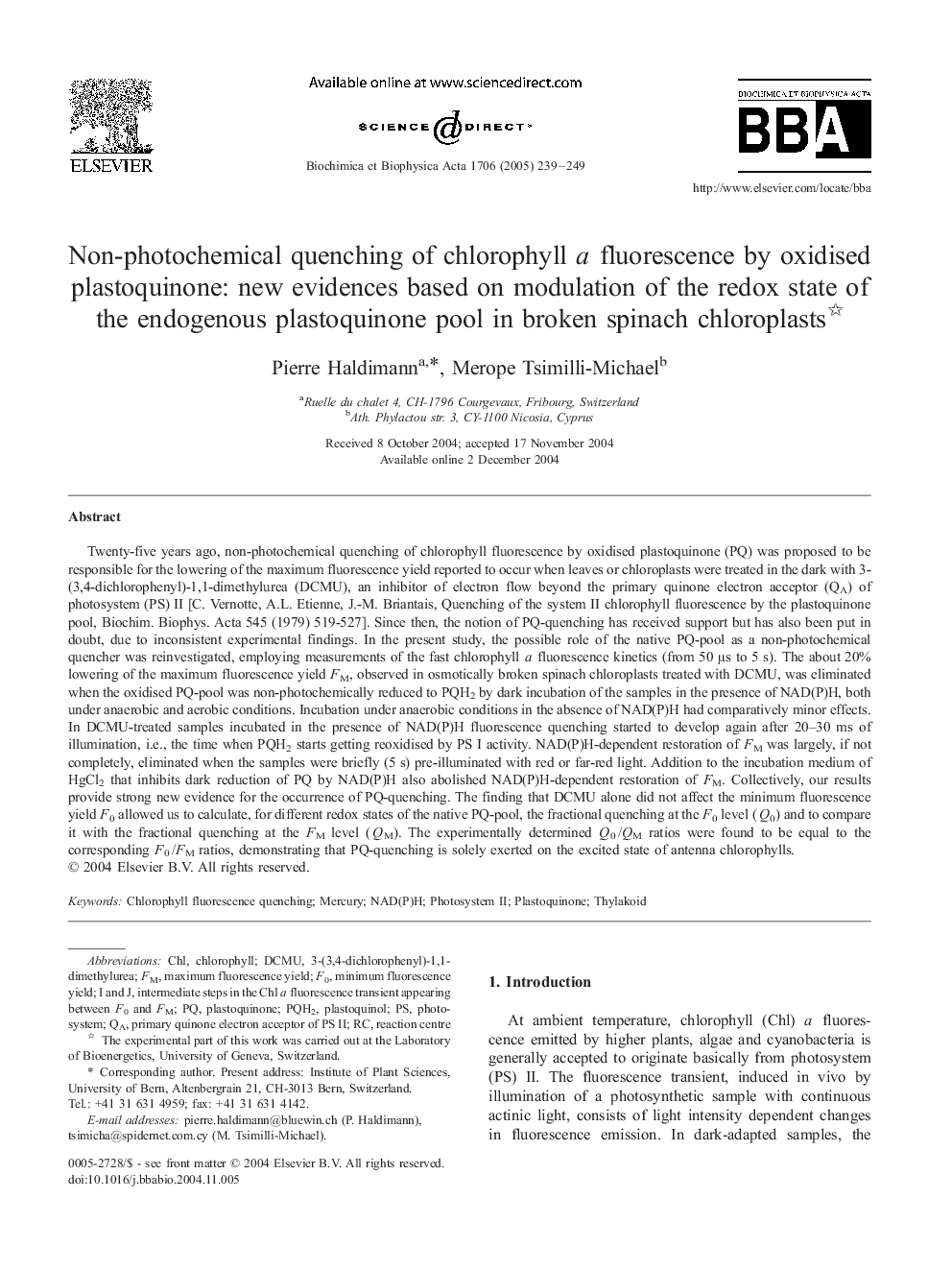| کد مقاله | کد نشریه | سال انتشار | مقاله انگلیسی | نسخه تمام متن |
|---|---|---|---|---|
| 10796153 | 1052697 | 2005 | 11 صفحه PDF | دانلود رایگان |
عنوان انگلیسی مقاله ISI
Non-photochemical quenching of chlorophyll a fluorescence by oxidised plastoquinone: new evidences based on modulation of the redox state of the endogenous plastoquinone pool in broken spinach chloroplasts
دانلود مقاله + سفارش ترجمه
دانلود مقاله ISI انگلیسی
رایگان برای ایرانیان
کلمات کلیدی
موضوعات مرتبط
علوم زیستی و بیوفناوری
علوم کشاورزی و بیولوژیک
دانش گیاه شناسی
پیش نمایش صفحه اول مقاله

چکیده انگلیسی
Twenty-five years ago, non-photochemical quenching of chlorophyll fluorescence by oxidised plastoquinone (PQ) was proposed to be responsible for the lowering of the maximum fluorescence yield reported to occur when leaves or chloroplasts were treated in the dark with 3-(3,4-dichlorophenyl)-1,1-dimethylurea (DCMU), an inhibitor of electron flow beyond the primary quinone electron acceptor (QA) of photosystem (PS) II [C. Vernotte, A.L. Etienne, J.-M. Briantais, Quenching of the system II chlorophyll fluorescence by the plastoquinone pool, Biochim. Biophys. Acta 545 (1979) 519-527]. Since then, the notion of PQ-quenching has received support but has also been put in doubt, due to inconsistent experimental findings. In the present study, the possible role of the native PQ-pool as a non-photochemical quencher was reinvestigated, employing measurements of the fast chlorophyll a fluorescence kinetics (from 50 μs to 5 s). The about 20% lowering of the maximum fluorescence yield FM, observed in osmotically broken spinach chloroplasts treated with DCMU, was eliminated when the oxidised PQ-pool was non-photochemically reduced to PQH2 by dark incubation of the samples in the presence of NAD(P)H, both under anaerobic and aerobic conditions. Incubation under anaerobic conditions in the absence of NAD(P)H had comparatively minor effects. In DCMU-treated samples incubated in the presence of NAD(P)H fluorescence quenching started to develop again after 20-30 ms of illumination, i.e., the time when PQH2 starts getting reoxidised by PS I activity. NAD(P)H-dependent restoration of FM was largely, if not completely, eliminated when the samples were briefly (5 s) pre-illuminated with red or far-red light. Addition to the incubation medium of HgCl2 that inhibits dark reduction of PQ by NAD(P)H also abolished NAD(P)H-dependent restoration of FM. Collectively, our results provide strong new evidence for the occurrence of PQ-quenching. The finding that DCMU alone did not affect the minimum fluorescence yield F0 allowed us to calculate, for different redox states of the native PQ-pool, the fractional quenching at the F0 level (Q0) and to compare it with the fractional quenching at the FM level (QM). The experimentally determined Q0/QM ratios were found to be equal to the corresponding F0/FM ratios, demonstrating that PQ-quenching is solely exerted on the excited state of antenna chlorophylls.
ناشر
Database: Elsevier - ScienceDirect (ساینس دایرکت)
Journal: Biochimica et Biophysica Acta (BBA) - Bioenergetics - Volume 1706, Issue 3, 17 February 2005, Pages 239-249
Journal: Biochimica et Biophysica Acta (BBA) - Bioenergetics - Volume 1706, Issue 3, 17 February 2005, Pages 239-249
نویسندگان
Pierre Haldimann, Merope Tsimilli-Michael,